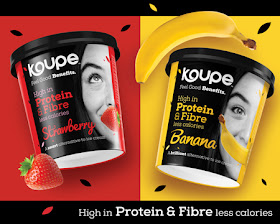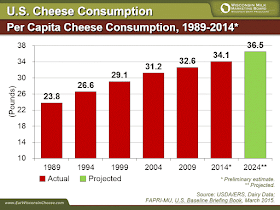During a phone interview this week, I was asked about opportunities in the dairy industry, specifically cheese. I gave my example of how pints of ice cream cost more than half gallons, and how consumers willingly dip into their pockets to pay more for less. They do this when they know the story of the product, understand the ingredients in the product and, when they know it’s just the right amount to satisfy their craving without feeling guilt for over consumption or waste.
With a growing number of single households, package sizes of many staples need to be reduced. This is likely why snack sizes have become so popular. They are just the right size.
Think shredded cheese. For long the norm has been the 8-ounce bag because family-size recipes often call for two cups. But what if you live alone and just want some shredded mozzarella to make a couple of pizza bagels. Maybe it’s time for a 4-ounce bag?
Kraft Heinz gets it. That 2-pound Velveeta loaf is too much of a commitment for most households these days. Velveeta tends to be a recipe cheese…melted with salsa for a queso dip, stirred into mashed potatoes or baked into a casserole. Two pounds of Velveeta is a commitment to cook. The company just rolled out Velveeta Mini Blocks. The 20-ounce box contains five individually wrapped 4-ounce cubes.
Indeed, committing to three square meals is just not the norm. Today’s consumers have moved away from traditional meal occasions and are snacking more throughout the day. They are seeking out healthier snacking options, with many dairy foods increasingly a convenient option.
With snacking now ubiquitous, more than three in five (64%) consumers agree that snacking is necessary to get through the day, including 77% of Millennials, according to new research from Mintel. Millennials are also more likely to be motivated by healthy snack options (68%).
Mintel data suggest that three in four (73%) consumers are willing to pay extra for snacks made with high-quality ingredients. This includes snacks based on cheese.
Recognizable brands play a role when choosing snacks, as seven in 10 (69%) consumers say snacks with branded ingredients prove to be higher quality than other snacks. Moreover, seven in 10 (71%) Millennials say snacks are best eaten while on the go.
The recently published report “Healthy-Ingredient Snacks in the U.S., 2nd Edition” from Packaged Facts confirms that healthy-ingredient snacks offer the perfect convergence of many important modern food industry trends and as a result the segment is thriving. Portable? Check. Healthy? Check. Transparent labels and packaging? Check. As a result of these factors, among others, the past five years has seen steady growth for healthy-ingredient snacks. The market’s compound annual growth rate (CAGR) of 4.7% has outpaced overall food and beverage sales growth.
Packaged Facts projects the healthy-ingredient snack segment will continue enjoying steady growth in sales. A CAGR of 5.7% is expected between 2016 and 2020.
A variety of industry trends are responsible for this bullish outlook. One of them is that protein, bite-sized snacks and innovative flavors are in high demand. Cheese can be all this and more.
Indeed, Millennials are a major driver of snacking. More than a third of consumers globally say they snack regularly, with the figure rising to just over 40% for young people aged 18 to 34, as the practice of modular eating becomes more accepted as an alternative to eating three main meals a day, according to consumer insight firm Canadean.
“Manufacturers are increasingly experimenting with a range of proteins, formats and gourmet flavors to elevate consumption from convenience-store snacks to an exciting taste experience and even credible meal replacement,” says Katrina Diamonon, principal-consumer insight at Canadean. “Improved sourcing transparency and ethical production of such offerings is also enhancing premium credentials.”
Recognizing the need for a convenient snack or easy entertaining solution, Dutch Farms jumped on the opportunity to better serve its customers. This month, Dutch Farms Cracker Cuts cheese hit retailers’ shelves in the Chicago area. Each 10-ounce package contains 20 pre-cut slices of pure, Wisconsin-made cheese. Cracker Cuts come in three varieties: Marble Jack, Pepper Jack and Sharp Cheddar. Dutch Farms Cracker Cuts are packaged in a re-sealable container so Cracker Cuts cheese can be enjoyed on more than one occasion without sacrificing grade-A freshness.
The Sincerely, Brigitte brand also recently debuted a cracker-cut tray of its flavorful cheeses. Each 12-ounce tray contains about 10 squares of four different cheeses. They are: Chipotle White Cheddar, Garlic Basil Monterey Jack, Orange Ginger Monterey Jack and Tomato Olive Monterey Jack.
Brigitte Mizrahi, CEO of Anderson International Foods Inc., is a French cheese connoisseur and the inspiration behind these unique flavors of cheese. She also is rolling out three varieties of individually wrapped cheese sticks that target mature taste buds. The varieties are: Chipotle White Cheddar, Garlic Basil Monterey Jack and Tomato Olive Monterey Jack. Each 4.5-ounce bag contains six 0.75-ounce sticks. The sticks are also available in merchandising units for individual sale.
Sargento is growing its multi-serve bags of snacking cheese. Sargento Snack Bites come in 6-ounce bags containing about 42 sticks. The line debuted earlier this year in four varieties: Chipotle BBQ Cheddar (mild cheddar with smoky BBQ seasoning), Colby-Pepper Jack (Monterey Jack with habanero and jalapeno), Savory Garlic & Herb Jack (Monterey Jack with garlic and herb seasoning) and Wisconsin Sharp Cheddar. Most recently, the company added Sweet Pepper Jack, which is Monterey Jack cheese seasoned with a mild sweet pepper blend. This variety was a limited-time offering sold through Costco variety packs.
The company also added two varieties to its Balanced Breaks line. This dual compartment package resembles ying yang, showing that opposites do attract, and in fact, complement each other quite well in these snacks. One compartment houses cheese bites and the other dried fruits and nuts. The new varieties are: Colby-Jack Natural Cheese with Sea Salted Peanuts & Blueberry Juice-Infused Dried Cranberries and Gouda Natural Cheese with Honey-Roasted Peanuts & Dried Cranberries. They join: Natural Sharp Cheddar Cheese, Sea Salted Cashews & Cherry Juice-Infused Cranberries; Natural Sharp White Cheddar Cheese, Sea Salted Cashews & Golden Raisin Medley; Natural White Cheddar Cheese, Sea Salted Roasted Almonds & Dried Cranberries; and Pepper Jack Natural Cheese, Honey Roasted Peanuts & Raisins.
“Our Balanced Breaks snacks was the most successful product launch in Sargento history and has exceeded sales expectations,” says Chris McCarthy, director of marketing for the Sargento Foods Consumer Products Division. “Expanding the available flavors is a natural move to give consumers the variety and convenience they want in snacks.”
Balanced Breaks snacks come in a package of three 1.5-ounce snacks for a suggested retail price of $3.69.
Arla Dofino Snack Cheese retails in 18-ounce packs containing a dozen or each Havarti Bars and Gouda Bars. Each individually wrapped bar is 0.75 ounces. The company also sells 6-ounce bags containing eight 0.75-ounce bars of Fontina, Gouda, Havarti or Medium Cheddar.
Saputo Specialty Cheese has introduced Organic Creamery Organic Light String Cheese for those snackers seeking out organic options. The single-serve sticks are conveniently packaged as six 1-ounce individual portions in a 6-ounce bag.
The cheese is hand-crafted by award-winning Wisconsin cheesemakers with organic milk from Wisconsin family farms that practice humane management and pasture grazing. With 50% less fat and 25% fewer calories than regular string cheese, Organic Creamery Light String Cheese has a mild and buttery flavor with a fun, pull-apart texture that serves a great addition to lunch boxes and afternoon snacks.
New Pro2snax single-serve snacks from Reichel include fresh produce paired with a healthy protein. Varieties are: Sweet Gala Apples with Almonds, Sliced Apples with Mild Cheddar Cheese, Carrots & Sriracha-Jack Cheese, Carrots with White Cheddar Cheese & Almonds, Apples & Cheddar w/Cranberries & Cashews, and Sweet Gala Apples, Cheddar Cheese & Pretzels.
Schuman Cheese now offers Yellow Door Creamery Brilliant Blue blue cheese. Handcrafted in Wisconsin and cellar-aged for 60 days, Brilliant Blue comes in individually wrapped 2-ounce portions and 5-ounce and 1-pound deli cups as mini cubes. Perfect for sandwiches, salads, cheese plates and more, Brilliant Blue can be easily stored for later use with a shelf life of 90 days. The mini cubes are clump free and sold with a flip top lid for ease of use. The 2-ounce single-serve cubes are great for slicing and melting.
Go ahead, snack on some cheese this weekend.














































